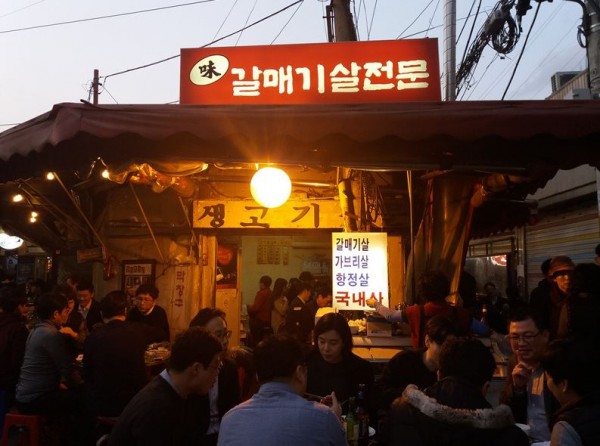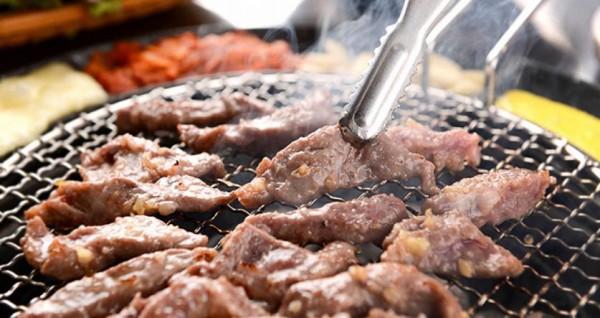한국어 어원 (Korean etymology) - 갈매기살 (seagull meat)
도우미
본문
갈매기살 (seagull meat)
고깃집에 웬 갈매기인가 하고 ‘갈매기살’하면 바다 갈매기를 떠올리면서 의아해 하는 사람들이 많다. '갈매기살‘은 돼지 내장의 ‘횡격막’에 붙어 있는 고기다. ‘횡격막’은 폐의 호흡을 돕는 근육성의 막인데 순수한 한국어로는 ‘가로막’이라고 했다. 뱃속을 가로로 막고 있는 막이란 뜻이다. 이 ‘가로막’에 붙어 있는 살을 ‘가로막살’이라고 한다. ‘가로막살’은 얇은 껍질로 덮여있는 근육질의 힘살로다른 부위의 고기보다 질기기 때문에 이 부위는 사람들이 별로 좋아하지 않았다. 그런데, 누군가가 거들떠보지도 않던 ‘가로막살’을 모아 껍질을 벗긴 뒤 팔기 시작하였다. 그 담백한 맛과 저렴한 가격 때문에 갑자기 인기가 많아졌다. 이 ‘가로막살’을 상품화하여 팔면서부터 ‘갈매기살’이라고 불리게 된 것이다.
가로막살 → 가로마기살 → 가로매기살 → 갈매기살
이런 언어적 변화 과정을 거쳐 오늘날 ‘바다 갈매기’와는 전혀 관련이 없는 재미있고 엉뚱한 ‘갈매기살’이란 이름이 생겨난 것이다.
There are many people who wonder what kind of seagull it is at a meat restaurant, and when they hear '갈매기살'‘seagull flesh’, they think of sea gulls. Because '갈매기'(galmaegi) in Korean is seagull.'갈매기살' is meat attached to the 'diaphragm' of pig intestines. The diaphragm is a muscular membrane that helps the lungs breathe. In pure Korean, it is called '가로막'. It is a membrane that horizontally blocks the stomach. The flesh attached to this ‘garomak’ is called ‘garomaksal’. 'Garomaksal' is a muscular muscle meat covered with a thin skin, which is tougher than other parts of the meat, so this part was not very popular with people. However, someone gathered and peeled the 'Garomaksal', which people did not even look at, and started selling them. Because of its mild taste and low price, it suddenly became popular. This 'garomaksal' was commercialized and sold, and it was called 'seagull meat'.
가로막살 → 가로마기살 → 가로매기살 → 갈매기살
Through this process of linguistic change, the funny and bizarre name of '갈매기살'(sea gull meat), which has nothing to do with today's '갈매기'(sea gull), was created.
✅ Learn Korean words & expressions
▪ 갈매기 (galmaegi) seagull
▪ 살 (sal) meat, flesh
▪ 갈매기살 (galmaegisal) the flesh of the pig's chest
▪ 돼지 (dwaeji) pig
▪ 고깃집 (gogisjib) meat restaurant
✅ Join to learn more. ▶ www.elkorean.kr/bbs/register.php
It is a paid class with professional native Korean teacher with Zoom or Skype.
오늘도 행복하세요.
Have a happy day!
고깃집에 웬 갈매기인가 하고 ‘갈매기살’하면 바다 갈매기를 떠올리면서 의아해 하는 사람들이 많다. '갈매기살‘은 돼지 내장의 ‘횡격막’에 붙어 있는 고기다. ‘횡격막’은 폐의 호흡을 돕는 근육성의 막인데 순수한 한국어로는 ‘가로막’이라고 했다. 뱃속을 가로로 막고 있는 막이란 뜻이다. 이 ‘가로막’에 붙어 있는 살을 ‘가로막살’이라고 한다. ‘가로막살’은 얇은 껍질로 덮여있는 근육질의 힘살로다른 부위의 고기보다 질기기 때문에 이 부위는 사람들이 별로 좋아하지 않았다. 그런데, 누군가가 거들떠보지도 않던 ‘가로막살’을 모아 껍질을 벗긴 뒤 팔기 시작하였다. 그 담백한 맛과 저렴한 가격 때문에 갑자기 인기가 많아졌다. 이 ‘가로막살’을 상품화하여 팔면서부터 ‘갈매기살’이라고 불리게 된 것이다.
가로막살 → 가로마기살 → 가로매기살 → 갈매기살
이런 언어적 변화 과정을 거쳐 오늘날 ‘바다 갈매기’와는 전혀 관련이 없는 재미있고 엉뚱한 ‘갈매기살’이란 이름이 생겨난 것이다.
There are many people who wonder what kind of seagull it is at a meat restaurant, and when they hear '갈매기살'‘seagull flesh’, they think of sea gulls. Because '갈매기'(galmaegi) in Korean is seagull.'갈매기살' is meat attached to the 'diaphragm' of pig intestines. The diaphragm is a muscular membrane that helps the lungs breathe. In pure Korean, it is called '가로막'. It is a membrane that horizontally blocks the stomach. The flesh attached to this ‘garomak’ is called ‘garomaksal’. 'Garomaksal' is a muscular muscle meat covered with a thin skin, which is tougher than other parts of the meat, so this part was not very popular with people. However, someone gathered and peeled the 'Garomaksal', which people did not even look at, and started selling them. Because of its mild taste and low price, it suddenly became popular. This 'garomaksal' was commercialized and sold, and it was called 'seagull meat'.
가로막살 → 가로마기살 → 가로매기살 → 갈매기살
Through this process of linguistic change, the funny and bizarre name of '갈매기살'(sea gull meat), which has nothing to do with today's '갈매기'(sea gull), was created.
✅ Learn Korean words & expressions
▪ 갈매기 (galmaegi) seagull
▪ 살 (sal) meat, flesh
▪ 갈매기살 (galmaegisal) the flesh of the pig's chest
▪ 돼지 (dwaeji) pig
▪ 고깃집 (gogisjib) meat restaurant
✅ Join to learn more. ▶ www.elkorean.kr/bbs/register.php
It is a paid class with professional native Korean teacher with Zoom or Skype.
오늘도 행복하세요.
Have a happy day!
Comments
Jack Doejokin
재미있는 단어입니다.
갈매기는 바다에서 볼 수 있는 새의 한 종류입니다.
Lily Stevens
So interesting.
고맙습니다.
Luke
Lol.
고맙습니다. 선생님.




 Customer Support Center
Customer Support Center